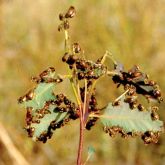Scarab beetles

Swarming scarab beetles (Automolius species) feeding on a eucalypt seedling
© Queensland Government

Defoliation in a eucalypt canopy caused by scarab beetles
© Queensland Government
Swarming scarab beetles (Coleoptera: Scarabaeidae) can be important pests in young eucalypt plantations. Several species, including Automolius species, Liparetrus species and Epholcis bilobiceps, are found in Queensland.
Because these beetles feed in swarms, and several different species can feed together, they can cause severe defoliation and/or dieback of the growing tips of young trees. Most damage occurs in spring to early summer when the adults emerge.
Scientific name
Other names
- Spring beetles
- Swarming scarab beetles
- Chafer beetles
Description
Automolius species
- Reddish brown to dark brown
- 4–5mm long
- Elytra (wing covers) covering most of the abdomen
- Short body hairs
- Active during daylight
Liparetrus species
- Light brown to brown
- 5–7mm long
- Elytra (wing covers) covering around two-thirds of the abdomen and often lighter in colour than the rest of the body
- Long body hairs on the end of the abdomen
- Mostly active at night, but some active during the day
Epholcis bilobiceps
- Reddish brown
- 5–7mm long
- Stiff hairs on the elytra (wing covers) and margins of the prothorax (body section bearing the first pair of legs)
- Characteristic head shape, with 2 strongly projecting lobes at the front
- Swarms of adults on trees at night, resting on trees or undergrowth during the day
- Swarms sometimes very large, covering the tree stem
Distribution
- Widespread throughout Queensland
- Epholcis bilobiceps limited to North Queensland's coastal areas from Iron Range to Townsville
Hosts
- Spotted gum (Corymbia citriodora subspecies. variegata)
- Cadaghi (C. torelliana)
- Rose gum and hybrids (Eucalyptus grandis)
- Dunn's white gum (E. dunnii)
- Western white gum (E. argophloia)
- Gympie messmate (E. cloeziana)
Damage
- Jagged leaf edges caused by adult beetles feeding on young eucalypt foliage, growing tips and coppice shoots
- Dieback and defoliation caused by swarms of feeding beetles
- Reduced early season growth and delayed forming of dominant central stem
- Feeding of larvae on roots of improved pasture grasses, turf and decaying organic matter – plantations surrounded by pasture particularly vulnerable
- Tree mortality in young or recently coppiced plantations that have repeated infestations
Biology
- Eggs are laid in the soil
- White larvae feed on fine grass roots and organic matter before pupating in the soil
- Adults appear en masse in spring or early summer, often after rain
Resources and research
- Carnegie, A, Lawson, SA, Smith, T, Pegg, GS, Stone, C, and McDonald, J 2008, Healthy hardwoods: a field guide to pests, diseases and nutritional disorders in subtropical hardwoods, Forest and Wood Products Australia, Victoria
- Jones, DL, Elliot, WR, Jones, SR, 2015, Pests, diseases, ailments and allies of Australian Plants, Reed New Holland Publishers Pty Ltd, Chatswood, NSW